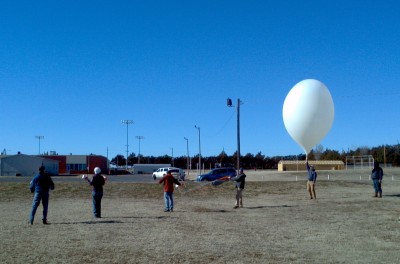
Each ARM site launches four balloon-borne sounding systems, or weather balloons, each day. The measurements they provide—temperature, pressure, humidity, and wind speed—are the backbone of many atmospheric-related research efforts. At the ARM Southern Great Plains site, operations personnel have conducted these launch duties for nearly 20 years. In mid-January, SGP staff shared their extensive balloon-launching experience with researchers embarking on a new approach for obtaining greenhouse gas measurements using a high-altitude balloon-borne sampling platform called AirCore.
Led by scientists Marc Fischer from DOE’s Lawrence Berkeley National Laboratory and Colm Sweeney from NOAA’s Earth System Research Laboratory, the Full-Column Greenhouse Gas Sampling science team requested the assistance of SGP site staff in conducting the pilot phase of a new AirCore sampling approach. First, they secured a location at Medicine Lodge High School in Kansas to conduct the launches. They then served as observers and advisors during the various steps of the launch process.
In all, the group of about 10 people completed four pilot launches and identified several areas for improving the efficiency of the somewhat labor-intensive process. In particular, SGP staff suggested the design and construction of a portable “launch cart” similar to the one they conceived of for ARM balloon launches. With the exception of Barrow, Alaska, this simple and cost-effective cart is now used at every ARM fixed and mobile site around the world.
Using this “lessons learned” approach, the group will reconvene in late spring to do another series of test launches toward the completion of their feasibility study phase. Ultimately, the objective is to streamline the process enough so that SGP staff can take over operations and conduct the launches in pairs at each change of season during the year. These measurements will provide key constraints for remote sensing measurements obtained from ground- and space-based instrument platforms and will be used to quantify vertical atmospheric profiles up to 30 kilometers.

